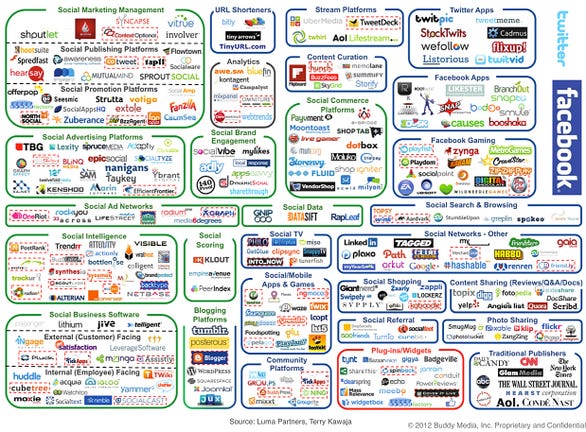The challenge of integrated marketing
There are dozens of ways for companies to interact with customers these days. Business Insider recently posted this infographic, only to realize that they’d left off Pintrest.
With all of these ways to touch customers, it’s no surprise that many times front-line customer support have no idea what marketing is telling customers and potential customers. This can lead to confusion and frustration on the part of a recipient. It can also cause previously loyal customers to consider different brands.
Take a bank that is launching a new suite of financial products. This bank sets up a lovely new domain to use in their email marketing. They send out an email to bank customers with that domain and encouraging customers to log in to the new system and take advantage of the new financial management products. From the recipient’s perspective it’s not clear if this mail is real or a phish. The recipient, being smart and somewhat savvy, calls the bank customer service line to verify this is real.
The customer support has not been told about the new suite of financial products, nor the new domain that the bank is using. As they are instructed, they inform the recipient that this mail is probably a phish and that the customer should not log into the bank website.
Result? Savvy bank customers don’t have full access to the full range of products and the bank loses revenue opportunities. Had the bank merely informed their front line support of the new marketing neither party would lose out.
Take another example. A major travel company sends out an email with the message that flight information has changed and the traveler must call the company immediately. The traveler calls the company trying to find out information about the change. The customer support representatives answering the phone number in the email have no idea what the traveler is talking about. Cue frustration and stress by the traveler.
Both examples primarily look at the lack of communication between email and call centers. It’s not surprising that the call centers have no idea what emails are being sent. But I don’t think it has to be that way. It should be possible to integrate emails into the support management portals in such a way that the front line folks can see what marketing is doing. Then, they can tell concerned callers,”oh, yes, we did launch a new product and the domain is greatbankdealsforyou.com and that’s a perfectly legitimate product. Would you like some more information over the phone or to log on to the website?”
There are a lot of major challenges in marketing these days, but integration across channels seems to be one that many companies don’t do or at least don’t do well. The worst part is, integration isn’t even mentioned in most of the conversations about social media I see. Social media is a great way to touch and interact with customers, but that touch only works if it doesn’t leave the customer feeling confused, angry or frustrated.
Could it be that the ROI on social media is so low because it’s treated as the red-headed step child of the company? Could it be that companies who can’t manage internal communications also can’t manage external ones? Social media is where everyone wants to be these days. But the promises aren’t being realized. Marketers need to interact with social media better if they ever want to gain traction with consumers. Part of that will be integrating social media marketing into their overall customer communication strategy.
